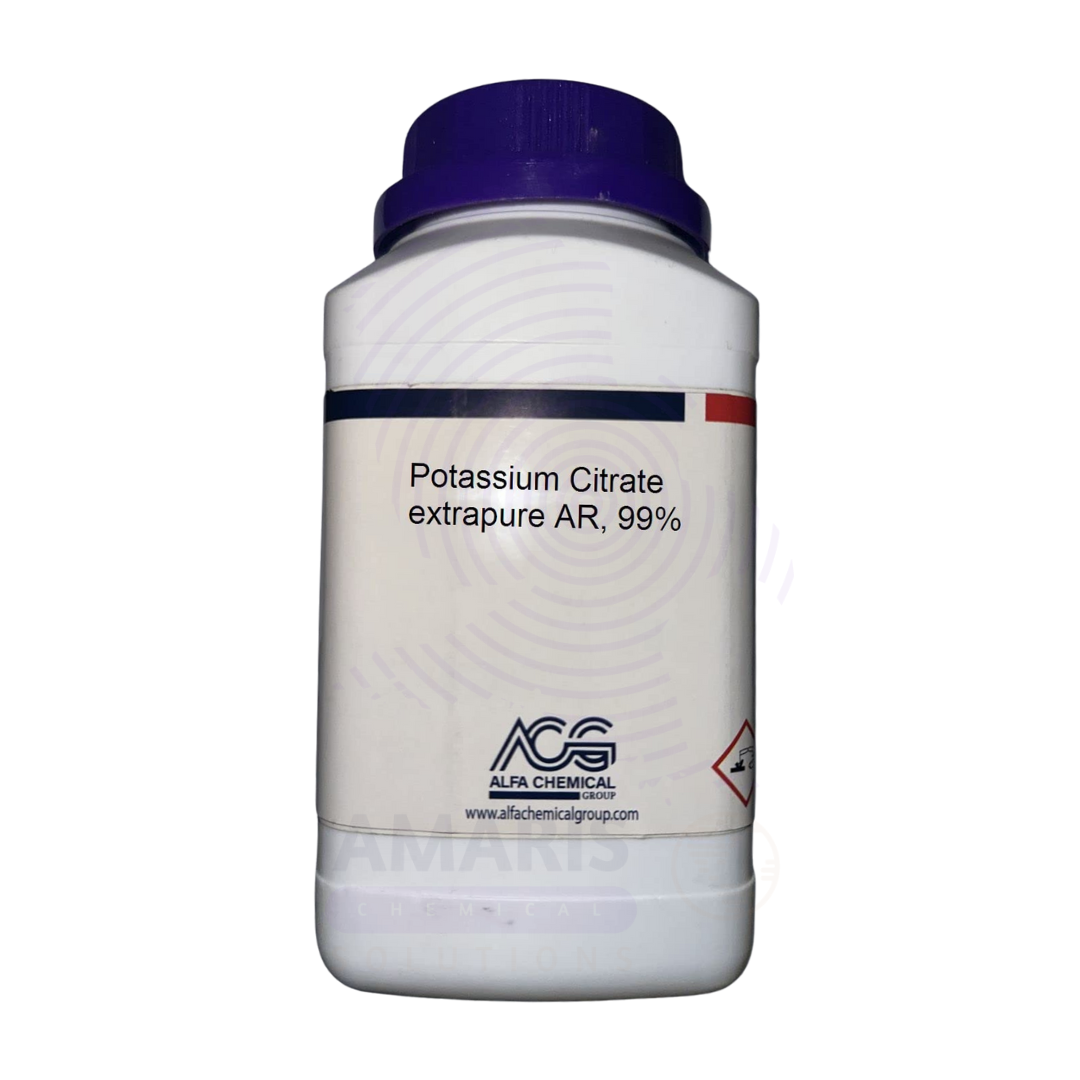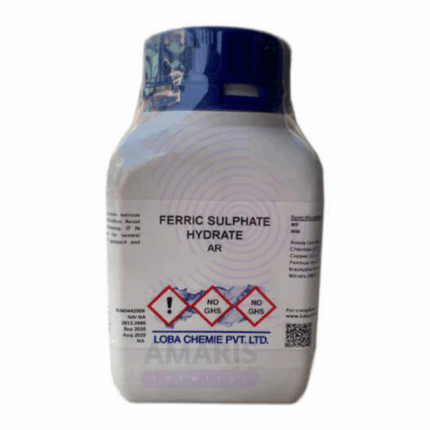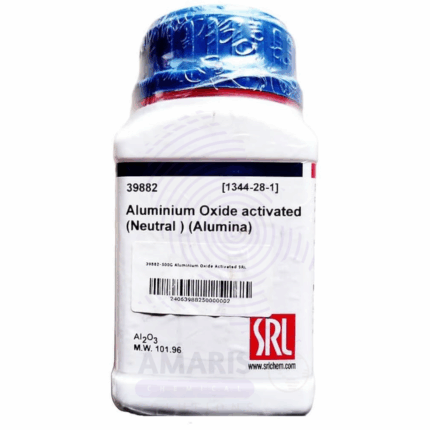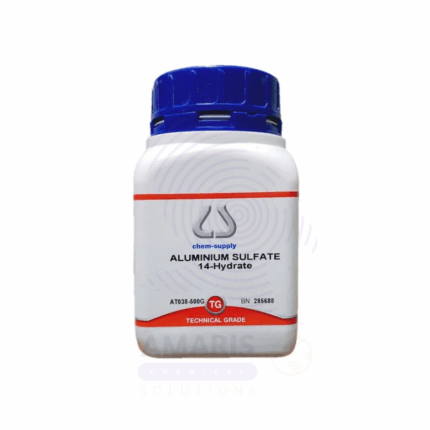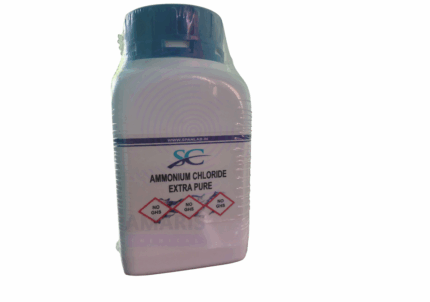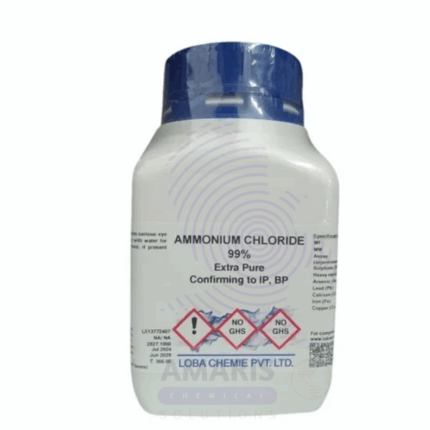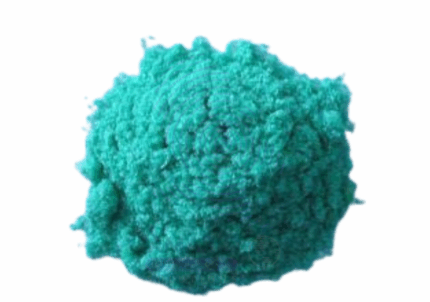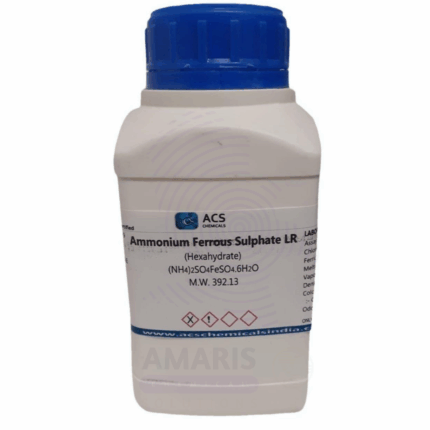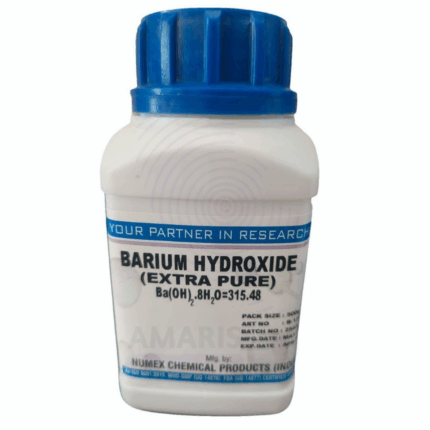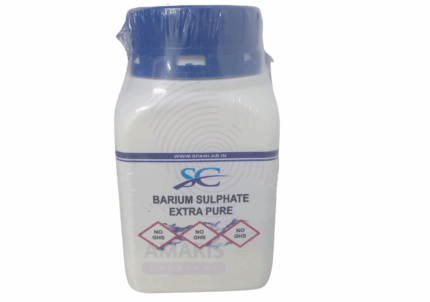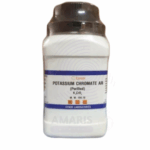
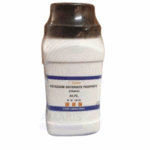
Potassium Citrate Extra Pure
$ 18.00 Original price was: $ 18.00.$ 17.78Current price is: $ 17.78.
Potassium Citrate Extra Pure is a fine, white crystalline powder recognized for its high solubility in water and excellent buffering capabilities. It is widely used in analytical chemistry and pharmaceutical formulations, particularly as a systemic alkalizer to manage conditions such as kidney stones or metabolic acidosis. In laboratories, it serves as a buffering agent in biochemical applications, helping to maintain stable pH conditions. Its compatibility with food and pharmaceutical standards also makes it useful in food science for flavor enhancement and preservation. This compound should be stored in a tightly sealed container in a dry environment to maintain its stability and prevent moisture absorption.
Potassium Citrate Extra Pure
PRIMARY USES
- Pharmaceutical Applications:
- Used to treat kidney stones by alkalinizing the urine (reducing acidity).
- Helps manage gout, renal tubular acidosis, and urinary tract disorders.
- Often used in oral rehydration salts (ORS) and electrolyte replacement therapies.
- Buffering Agent:
- Acts as a pH buffer in pharmaceutical, biochemical, and food formulations.
- Helps maintain stable pH in diagnostic reagents and laboratory solutions.
- Food Additive:
- Used as a preservative, acidity regulator, and stabilizer (E332).
- Common in beverages, processed cheese, and powdered drinks.
SECONDARY USES
- Nutritional Supplement:
- Used in dietary formulations to increase potassium intake and support electrolyte balance.
- Cosmetics and Personal Care:
- Included in formulations for its chelating and buffering
- May help control product pH and enhance skin feel.
- Laboratory Research:
- Employed in experiments requiring potassium ions in controlled pH conditions.
1. Basic Identification Attributes
- Chemical Name: Potassium Citrate
- CAS Number: 866-84-2
- HS Code: 2918.15.00
- Molecular Formula: C₆H₅K₃O₇
- Synonyms:
- Tripotassium citrate
- Citrate of potassium
- Potassium salt of citric acid
2. Physical & Chemical Properties
- Physical State: Solid (granules or crystalline powder)
- Color & Odor: White, odorless
- Boiling Point & Melting Point:
- Melting Point: Decomposes above 230 °C
- Boiling Point: Not applicable (decomposes before boiling)
- Density/Specific Gravity: ~1.98 g/cm³
- Solubility:
- Highly soluble in water (~200 g/L at 20 °C)
- Practically insoluble in alcohol
- pH Level: ~7.5 to 9.0 (5% aqueous solution)
- Vapor Pressure & Volatility: Not volatile
- Flash Point: Not flammable
- Autoignition Temperature: Not applicable
- Viscosity: Not applicable (solid)
3. Safety & Hazard Attributes
- Hazard Class (GHS Classification):
- Not classified as hazardous under GHS
- NFPA Ratings:
- Health: 1
- Flammability: 0
- Reactivity: 0
- Exposure Limits:
- No specific OSHA or ACGIH limits; considered safe in common use
- Reactivity:
- Stable under normal conditions
- May react with strong acids or oxidizers
4. Storage & Handling Attributes
- Storage Conditions:
- Store in tightly sealed containers in a cool, dry place
- Avoid exposure to moisture
- Incompatible Materials:
- Strong acids (can release citric acid and CO₂)
- Container Type:
- Plastic or glass containers with moisture-resistant lining
- Shelf Life & Expiration Date:
- Stable for up to 3 years under proper storage
- Special Handling Requirements:
- Standard lab PPE (gloves, goggles) recommended
- Avoid inhalation of dust
5. Regulatory & Compliance Attributes
- Regulatory Status:
- GRAS (Generally Recognized As Safe) by FDA
- Listed under TSCA inventory
- Compliant with USP/FCC standards for food and pharmaceutical use
- Hazard Symbols (GHS Pictograms):
- None required for this substance
- Transportation Restrictions:
- Not regulated for transport
- Waste Disposal Method:
- Dispose according to local environmental regulations
- Non-hazardous waste under most disposal guidelines
6. Environmental & Health Impact
- Ecotoxicity:
- Low aquatic toxicity
- Persistence in Environment:
- Biodegradable; breaks down into citric acid and potassium salts
- Carcinogenicity/Mutagenicity:
- Not classified as carcinogenic or mutagenic
- Biodegradability:
- Readily biodegradable
- Readily biodegradable
SAFETY PRECAUTIONS
Personal Protective Equipment (PPE):
- Wear protective gloves (nitrile or latex).
- Use safety goggles to prevent eye contact.
- Wear a laboratory coat or apron.
- Ensure good general ventilation during handling.
Handling:
- Avoid generating dust.
- Do not breathe dust or ingest.
- Wash hands thoroughly after handling.
- Avoid contact with eyes and prolonged skin exposure.
Storage:
- Store in a tightly sealed container.
- Keep in a cool, dry, and well-ventilated area.
- Protect from moisture and incompatible substances (e.g., strong acids).
FIRST AID MEASURES
Inhalation:
- Move people to fresh air.
- Seek medical attention if respiratory symptoms develop.
Skin Contact:
- Wash thoroughly with soap and water.
- Seek medical attention if irritation persists.
Eye Contact:
- Rinse cautiously with water for at least 15 minutes.
- Remove contact lenses if present and easy to do.
- Get medical advice if irritation occurs.
Ingestion:
- Rinse mouth with water.
- Do not induce vomiting.
- Seek medical attention, especially if large quantities are ingested.
FIRE FIGHTING MEASURES
Flammability:
- Non-flammable.
Extinguishing Media:
- Use water spray, dry chemical, foam, or carbon dioxide depending on the surrounding fire.
Hazardous Combustion Products:
- May emit potassium oxides and carbon oxides when decomposed at high temperatures.
Firefighter Protection:
- Wear full protective gear and self-contained breathing apparatus (SCBA).
- Avoid inhalation of combustion fumes.


 Preservatives(food)
Preservatives(food) Flavor Enhancers
Flavor Enhancers Acidulants
Acidulants Sweeteners
Sweeteners Antioxidants
Antioxidants Colorants(food)
Colorants(food) Nutraceutical Ingredients (food)
Nutraceutical Ingredients (food) Nutrient Supplements
Nutrient Supplements Emulsifiers
Emulsifiers
 Collectors
Collectors Dust Suppressants
Dust Suppressants Explosives and Blasting Agents
Explosives and Blasting Agents Flocculants and Coagulants
Flocculants and Coagulants Frothers
Frothers Leaching Agents
Leaching Agents pH Modifiers
pH Modifiers Precious Metal Extraction Agents
Precious Metal Extraction Agents
 Antioxidants(plastic)
Antioxidants(plastic) Colorants (Pigments, Dyes)
Colorants (Pigments, Dyes) Fillers and Reinforcements
Fillers and Reinforcements Flame Retardants
Flame Retardants Monomers
Monomers Plasticizers
Plasticizers Polymerization Initiators
Polymerization Initiators Stabilizers (UV, Heat)
Stabilizers (UV, Heat)
 Antifoaming Agents
Antifoaming Agents Chelating Agents
Chelating Agents Coagulants and Flocculants
Coagulants and Flocculants Corrosion Inhibitors
Corrosion Inhibitors Disinfectants and Biocides
Disinfectants and Biocides Oxidizing Agents
Oxidizing Agents pH Adjusters
pH Adjusters Scale Inhibitors( water)
Scale Inhibitors( water)
 Antioxidants(cosmetic)
Antioxidants(cosmetic) Emollients
Emollients Fragrances and Essential Oils
Fragrances and Essential Oils Humectants
Humectants Preservatives
Preservatives Surfactants(cosmetic)
Surfactants(cosmetic) Thickeners
Thickeners UV Filters
UV Filters
 Fertilizers
Fertilizers Soil Conditioners
Soil Conditioners Plant Growth Regulators
Plant Growth Regulators Animal Feed Additives
Animal Feed Additives Biostimulants
Biostimulants Pesticides (Herbicides, Insecticides, Fungicides)
Pesticides (Herbicides, Insecticides, Fungicides)
 Active Pharmaceutical Ingredients (APIs)
Active Pharmaceutical Ingredients (APIs) Excipients
Excipients Solvents(pharmaceutical)
Solvents(pharmaceutical) Antibiotics
Antibiotics Antiseptics and Disinfectants
Antiseptics and Disinfectants Vaccine Adjuvants
Vaccine Adjuvants Nutraceutical Ingredients (pharmaceutical)
Nutraceutical Ingredients (pharmaceutical) Analgesics & Antipyretics
Analgesics & Antipyretics
 Analytical Reagents
Analytical Reagents Solvents(lab)
Solvents(lab) Chromatography Chemicals
Chromatography Chemicals Spectroscopy Reagents
Spectroscopy Reagents microbiology-and-cell-culture-reagents
microbiology-and-cell-culture-reagents Molecular Biology Reagents
Molecular Biology Reagents Biochemical Reagents
Biochemical Reagents Inorganic and Organic Standards
Inorganic and Organic Standards Laboratory Safety Chemicals
Laboratory Safety Chemicals Specialty Laboratory Chemicals(Special Laboratory Equipment)
Specialty Laboratory Chemicals(Special Laboratory Equipment)
 Demulsifiers
Demulsifiers Hydraulic Fracturing Fluids
Hydraulic Fracturing Fluids Scale Inhibitors(oil)
Scale Inhibitors(oil) Surfactants(oil)
Surfactants(oil) Drilling Fluids
Drilling Fluids
 Dyes and Pigments
Dyes and Pigments Bleaching Agents
Bleaching Agents Softening Agents
Softening Agents Finishing Agents
Finishing Agents Antistatic Agents
Antistatic Agents
 Admixtures
Admixtures Waterproofing Agents
Waterproofing Agents Sealants and Adhesives
Sealants and Adhesives Curing Compounds
Curing Compounds Concrete Repair Chemicals
Concrete Repair Chemicals Anti-Corrosion Coatings
Anti-Corrosion Coatings
 Surfactants(cleaning)
Surfactants(cleaning) Builders
Builders Enzymes
Enzymes Solvents (Cleaning)
Solvents (Cleaning) Fragrances
Fragrances
 Electronic Chemicals
Electronic Chemicals Catalysts
Catalysts Lubricants
Lubricants Photographic Chemicals
Photographic Chemicals Refrigerants
Refrigerants Automotive chemicals
Automotive chemicals Pyrotechnic Chemicals
Pyrotechnic Chemicals
 Biodegradable Surfactants
Biodegradable Surfactants Bio-based Solvents
Bio-based Solvents Renewable Polymers
Renewable Polymers Carbon Capture Chemicals
Carbon Capture Chemicals Wastewater Treatment Chemicals
Wastewater Treatment Chemicals
 Pigments
Pigments Solvents(paint)
Solvents(paint) Specialty Coatings
Specialty Coatings Binders/Resins
Binders/Resins Additives
Additives Driers
Driers Anti-Corrosion Agents
Anti-Corrosion Agents Functional Coatings
Functional Coatings Application-Specific Coatings
Application-Specific Coatings
 Fresh Herbs
Fresh Herbs Ground Spices
Ground Spices Whole Spices
Whole Spices Spice Blends
Spice Blends Dried Herbs
Dried Herbs
 Leavening Agents
Leavening Agents Dough Conditioners
Dough Conditioners Flour Treatments
Flour Treatments Fat Replacers
Fat Replacers Decoratives
Decoratives Preservatives(baking)
Preservatives(baking)
 Plasticizers & Softeners
Plasticizers & Softeners Reinforcing Agents
Reinforcing Agents Adhesion Promoters
Adhesion Promoters Vulcanizing Agents
Vulcanizing Agents Antidegradants
Antidegradants Blowing Agents
Blowing Agents Fillers & Extenders
Fillers & Extenders Accelerators & Retarders
Accelerators & Retarders